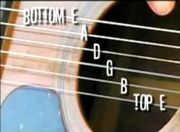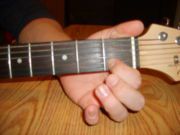Learn How To Play Guitar Chords Easily
The guitar is especially versatile not only because it can be used in a wide variety of styles of music but also because it's more approachable than many other instruments, once you master a few basics as outlined below. It may take you years to get the basics down, and you'll need formal instruction at some point, but this simplified overview can get you started today. This article focuses on standard chords, which are only a basic element of guitar potential. For those who have significant difficulty forming chord shapes with their fingers, it may be better to start off learning songs which utilize single notes or power chords. This will help build finger strength, dexterity, and familiarity with the guitar, hopefully with less stress and frustration.
General Steps:
 1. Tune Your Guitar Yourself
1. Tune Your Guitar Yourself This will not only help your playing sound better, but it'll also familiarize you with which string and fret combinations correspond with which notes. A useful mnemonic to remember the string arrangement is "Every Body Gets Dinner At Eight" (going from high E to low E) or "E"at "A"ll "D"ay "G"et "B"ig "E"asy (low to High). You should try to make up your own acronym, it will help you remember more easily.
2. Learn How To Read Guitar Tabs & Notes
Guitarists have their own system of music notation called guitar tablature, or "guitar tabs" for short. The basic idea is to look at the tab in the same way you look at your guitar; each line corresponds to a string, and each number tells you which fret to hold down when plucking that string.
-
E---------------3-0--------------------|| - B-------------------3-0----------------||
- G---7-7-7---------------2-0------------||
- D-2-7-7-7-7-7-7------------------------||
- A-2-5-5-5-7-7-7------------------------||
- E-0-------5-5-5------------------------||
3. On the first fret.

Place your fingers correctly on the frets. Right-handed players use their left hand for fretting and use their right hand for picking. The frets are the metal strips that run perpendicular to the strings. You actually press your finger down between the metal strips, not on them. For example, if you're playing the third fret, you place your finger on the string between the second and third metal strip. Hold the string down firmly so that it only vibrates between your finger and your strumming hand. Do not forget that you must play on your fingertips and not on the soft part of your finger. This requires cutting your nails to avoid scratching the fretboard. Place your finger as close to the fret as possible to create a good sound.
C Major chord
When you hold down multiple strings at once at different frets, it can be a little tricky. There are usually several different ways to position your fingers for the same chord, so research them and experiment to find which one feels most comfortable for you. Keep in mind that every time you move from one fret to another, the resulting pitch will be half a step higher or lower (i.e. "sharp" or "flat"). This is important for if you want to eventually read and play from sheet music. Some people find that placing the thumb in the middle of the back of the neck, not coming over the top, leads to better finger placement because it allows better reach and strength of the fingers on the frets. Ultimately, however, do what feels best for you.
4. Strum with your other hand.
This can be the most difficult part to learn without having a teacher demonstrate. Strumming consists of downstrokes and upstrokes in various combinations. Count every beat and off-beat as "1 and 2 and 3 and 4 and..." (every "and" is an offbeat). Each beat and offbeat can be an upstroke, downstroke, or no stroke. No matter which direction you use, make an effort to sweep across all of the strings with even pressure and steady speed. You don't want to strum some strings a little harder than others, or start off fast then slow down as you get to the last few strings. The motion should come mostly from the wrist, not the forearm.
You can do this with a pick or with your fingertips. There are various kinds of picks you can use, but beginners are usually advised to start with a thin pick, held between the thumb and the side of the index finger.
Keep your arm going in a constant up-and-down motion, sticking with a rhythm whether or not you're actually strumming. This motion functions as a metronome for beginners. As you get better at strumming, you can tap your foot, bob your head, or jerk your knee like Elvis instead.
5. Practice chords.
A chord is a group of notes that sound good together. The reason they sound good together lies in music theory, but for now, learning how to play a few key chords will suffice. Practice until you can move comfortably between them without losing your rhythm.
The most commonly used chords in Western music are the major chords, which can be remembered with the word "CAGED". Click on any of the following links for specific instructions on how to play each chord:
Start off with easier songs - ones with fewer chords in simpler arrangements. Listen to the song being played properly with guitar so you know what kind of sound and rhythm to aim for. Start off slow and speed up gradually, singing along (if applicable) to stick with the rhythm. As you master easier songs, move on to more complex pieces. Sweet Home Alabama by Lynyrd Skynyrd is an example of an easier song to start with. It's basically a repetition of the same three chords in the following order: D, C, and G.
For more information: How to play Guitar
Will post some more tricks and tips and how to play guitar from guitar videos in my next post.
It would be my pleasure to share some basic guitar coaching for all guitar learners. So please visit My Blog.
C Major chord

When you hold down multiple strings at once at different frets, it can be a little tricky. There are usually several different ways to position your fingers for the same chord, so research them and experiment to find which one feels most comfortable for you. Keep in mind that every time you move from one fret to another, the resulting pitch will be half a step higher or lower (i.e. "sharp" or "flat"). This is important for if you want to eventually read and play from sheet music. Some people find that placing the thumb in the middle of the back of the neck, not coming over the top, leads to better finger placement because it allows better reach and strength of the fingers on the frets. Ultimately, however, do what feels best for you.
4. Strum with your other hand.
This can be the most difficult part to learn without having a teacher demonstrate. Strumming consists of downstrokes and upstrokes in various combinations. Count every beat and off-beat as "1 and 2 and 3 and 4 and..." (every "and" is an offbeat). Each beat and offbeat can be an upstroke, downstroke, or no stroke. No matter which direction you use, make an effort to sweep across all of the strings with even pressure and steady speed. You don't want to strum some strings a little harder than others, or start off fast then slow down as you get to the last few strings. The motion should come mostly from the wrist, not the forearm.
You can do this with a pick or with your fingertips. There are various kinds of picks you can use, but beginners are usually advised to start with a thin pick, held between the thumb and the side of the index finger.
Keep your arm going in a constant up-and-down motion, sticking with a rhythm whether or not you're actually strumming. This motion functions as a metronome for beginners. As you get better at strumming, you can tap your foot, bob your head, or jerk your knee like Elvis instead.
5. Practice chords.
A chord is a group of notes that sound good together. The reason they sound good together lies in music theory, but for now, learning how to play a few key chords will suffice. Practice until you can move comfortably between them without losing your rhythm.
The most commonly used chords in Western music are the major chords, which can be remembered with the word "CAGED". Click on any of the following links for specific instructions on how to play each chord:
- C Major
- A Major
- G Major
- E Major
- D Major
Start off with easier songs - ones with fewer chords in simpler arrangements. Listen to the song being played properly with guitar so you know what kind of sound and rhythm to aim for. Start off slow and speed up gradually, singing along (if applicable) to stick with the rhythm. As you master easier songs, move on to more complex pieces. Sweet Home Alabama by Lynyrd Skynyrd is an example of an easier song to start with. It's basically a repetition of the same three chords in the following order: D, C, and G.
For more information: How to play Guitar
Will post some more tricks and tips and how to play guitar from guitar videos in my next post.
It would be my pleasure to share some basic guitar coaching for all guitar learners. So please visit My Blog.
